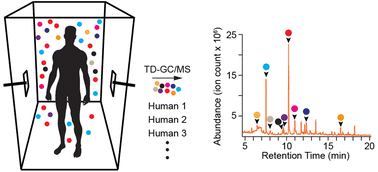A headspace collection chamber for whole body volatilomics†
Abstract
The human body secretes a complex blend of volatile organic compounds (VOCs) via the skin, breath and bodily fluids, the study of which can provide valuable insight into the physiological and metabolic state of an individual. Methods to profile human-derived volatiles typically source VOCs from bodily fluids, exhaled breath or skin of isolated body parts. To facilitate profiling the whole body volatilome, we have engineered a sampling chamber that enables the collection and analysis of headspace from the entire human body. Whole body VOCs were collected from a cohort of 20 humans and analyzed by thermal desorption-gas chromatography/mass spectrometry (TD-GC/MS) to characterize the compounds present in whole body headspace and evaluate chemical differences between individuals. A range of compounds were detected and identified in whole body headspace including ketones, carboxylic acids, aldehydes, alcohols, and aliphatic and aromatic hydrocarbons. Considerable heterogeneity in the chemical composition of whole body odor and the concentration of its constituent compounds was observed across individuals. Amongst the most common and abundant compounds detected in human whole body odor were sulcatone, acetoin, acetic acid and C6–C10 aldehydes. This method facilitates standardized and quantitative analytical profiling of the human whole body volatilome.

- This article is part of the themed collection: 150th Anniversary Collection: Separation Science


 Please wait while we load your content...
Please wait while we load your content...